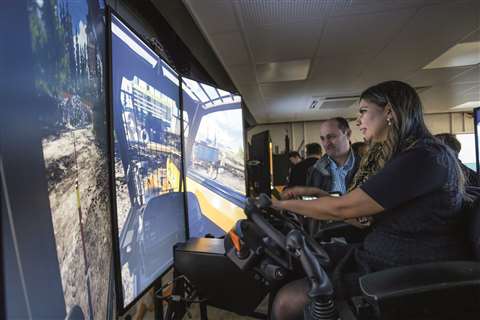Construction skills crisis
26 July 2022
Construction has an image problem that is holding back recruitment when it is most needed. Mike Hayes looks at possible solutions to the growing workforce crisis.
 (PHOTO: KHL)
(PHOTO: KHL)
Today, construction is facing a serious skills crisis, with nearly a quarter of the current workforce expected to retire in the next ten years and a significant disparity between those leaving the sector and those entering it.
At the same time, it has been identified by The European Commission as a vital driver for recovery, following the economic downturn caused by the coronavirus pandemic.
But the age-old image of construction work being dirty, dangerous and demeaning can make it seem a less than perfect career move for a younger generation that is seeing job prospects booming, with low levels of unemployment being reported in most European countries.
Construction employment trends
Construction, of course, had a problem with a shortage of skilled labour long before Covid appeared.
In 2019, the European Construction Industry Federation, FIEC, released a statement, in conjunction with 17 other industry bodies, highlighting a need for improved skills matching, for the future prosperity of the bloc.
 Christine Le Forestier, director of social affairs at FIEC. (PHOTO: FIEC)
Christine Le Forestier, director of social affairs at FIEC. (PHOTO: FIEC)
The statement said the growing skills shortage, if left unaddressed, “…will have a negative impact on innovation and productivity, both in highly innovative industry sectors and other services sectors, some of which are already confronted with the challenge of attracting motivated and competent workers.”
Today, FIEC’s director of social affairs, Christine Le Forestier, says few things have changed since the statement was written – unless it is for the worse.
“The situation has been difficult, both in terms of the mobility of the workers and the mobility of supplies,” she says.
“In some places it has been tougher than others; in Italy and in Ireland, for example. In these circumstances, you can expect some people will leave the industry.
Workplace trends: shifting worker expectations
“We see it also as a general trend. There’s been something of a life crisis for some people; it’s made them look for something different. That’s not specific to construction, but it has affected our industry.
“Before the pandemic, we were already talking about digital transition and green transition. The European Commission has also taken the trend…with the renovation wave flagship initiative. So, we have the skills shortage in combination with challenges for which we need a lot more people. Clearly there is a clash between the two.”
Forestier adds that, “The challenge that we have ahead is also an opportunity – this transition to make our sector more attractive for the younger generation.
“We have to say look, it’s becoming more digital; look, it’s becoming greener.”
Digital technology is now recognised as a genuine megatrend in the industry, with many of the largest construction companies making technology acquisitions. So, is tech the answer?
 Cameron Clark, earthmoving industry director at Trimble Civil Infrastructure Solutions. (PHOTO: Trimble)
Cameron Clark, earthmoving industry director at Trimble Civil Infrastructure Solutions. (PHOTO: Trimble)
The growth of technology
Cameron Clark, earthmoving industry director at Trimble Civil Infrastructure Solutions, believes it can help – in more ways than one.
He says, “At Trimble, we are focused on developing technology that can dramatically increase the productivity of lesser-skilled workers, for example through operator assistance features.
“This helps overcome the challenge of there being fewer and fewer highly experienced machine operators in the workforce and has the added benefit of making new operators feel proud and confident in what they can accomplish with advanced technology.”
Clark adds that technology will hold no fears for the next generation of construction workers.
“The next generation of construction workers are digital natives,” he says. “They grew up playing video games and using handheld devices as part of their daily lives, and they are absolutely looking for jobs with contractors who are investing in modern technology.”
 AccXel aims to address the skills shortage by utilising technology for training. (PHOTO: AccXel)
AccXel aims to address the skills shortage by utilising technology for training. (PHOTO: AccXel)
“We have customers who are relying heavily on technology to grow their companies – by hiring young workers who are excited about automation, robotics, augmented reality and other advanced technologies, and then using the benefits of their growing team to take on more and new types of projects.”
Women in construction
Utilising construction technology has also become a key factor for AccXel, a UK firm aiming to tackle the skills shortage and train civil engineers, groundworkers and plant operators – as well as to encourage more women to join the industry, potentially a key factor in tackling the skills shortage issue.
The company uses virtual reality training simulators to provide real-world representations of the operation of plant machinery and provide a safe environment for plant apprentices.
 Nicola Bird, founder and managing director of AccXel. (PHOTO: AccXel)
Nicola Bird, founder and managing director of AccXel. (PHOTO: AccXel)
Nicola Bird, founder and managing director of AccXel, said, “One of my main reasons for founding AccXel, was to create bespoke training programmes which better suited the industry.
“Traditional apprenticeship schemes don’t offer a comprehensive package of learning and development and wouldn’t be able to support the growth of the industry.
Bird says being the only woman in the boardroom has enabled her to understand the challenges of growing as a professional in a male-dominated industry.
“Women are vastly underrepresented in construction and currently make up just 11% of the whole industry. This is yet another issue we want to work towards solving at AccXel.
“We believe having women represent 15% of our apprentice mix is a strong statement to the industry and we will continue to pioneer and provide equal opportunity to young women across all sector roles.”
Equipment manufacturing skills
Construction equipment manufacturers are also feeling the skills shortage pinch, as well as the high price and scarcity of materials.
Roger Simonsson, CEO of Aquajet, which produces hydrodemolition robots, says, “Everyone is experiencing labour shortages to some degree, but that doesn’t mean there aren’t solutions to the problem.”
He sees a positive for companies like his, which replace a lot of tough manual labour with advanced technology.
 Roger Simonsson, CEO of hydrodemolition equipment manufacturer Aquajet. (PHOTO: Aquajet)
Roger Simonsson, CEO of hydrodemolition equipment manufacturer Aquajet. (PHOTO: Aquajet)
He believes his customers are reaping the rewards of moving away from manual methods of concrete removal, like jackhammers and hand lances, by investing in automated solutions.
If technology is a way of improving both productivity and operator experience, both workers and employers benefit.
Simonsson believes the next generation of workers understands that construction will never be an easy job and often involves physically demanding work.
However he insists that, “When contractors invest in advanced equipment, with remote capabilities and smart technology, it piques the interest of the next generation of workers.
“With benefits like less wear on the body, no exposure to silica dust, easy user interfaces and cutting-edge technology, this next generation of equipment is a win for everyone involved.”
Overcoming the digital skills gap
 (PHOTO: Adobe Stock)
(PHOTO: Adobe Stock)
At the end of 2021, Shell published its report, Under Pressure: Leading in Paradox Industries, which addressed the digital skills gap in construction.
Here, Kerstin Greiner, general manager of the Off Highway division of Shell Deutschland Oil, describes the growing need for new digital skills in construction in the face of an ongoing labour shortage in Europe…
“Leaders realise that a shift needs to take place – with 85% [of survey respondents] saying that most of their workforce will need some sort of retraining to adapt to digital transformation.
“Meanwhile, three-quarters say a lack of expertise and training is a barrier to their ability to transform digitally as a business.
“In practical terms, this will see businesses struggle to maximise their investments in digitalisation. For example, companies investing in cutting-edge solutions like digital twins will be hampered not only by legacy systems but also by workers with the lack of skills – or access to training – to use them effectively.”
“It’s no surprise then that six out of ten leaders believe that helping employees to develop new skills and ways of working will be one of the top three drivers of opportunity for their company
 (PHOTO: Adobe Stock)
(PHOTO: Adobe Stock)
Growth is in jeopardy in UK construction
In the UK, job vacancies are running at a record high, with unemployment at its lowest level in 50 years.
According to the latest small business index insights report from software firm Xero, construction and manufacturing saw the biggest drop of employee number of any sector – a 10% year-on-year reduction.
As construction makes up 7.2% of total employment in small firms, an inability to fill vacancies in the sector will have severe implications for the rest of the economy.
Meanwhile, the Construction Industry Training Board (CITB) recently produced its annual forecast in which it said the UK will not meet its projected growth prospects unless an additional 266,000.
If projected growth is met, construction employment could reach a high of nearly 2.78 million workers by 2026.
This comes as CITB urges industry and government to come together in refreshing the way the industry hires and trains, making construction an attractive place for everyone to work.
CITB CEO Tim Balcon said, “The industry has a lot to offer, and there is so much potential to engage in a career that sees you enter the industry as an apprentice and leave it as a CEO. The industry needs to use its many strengths to attract and retain top talent in a competitive recruitment landscape
“Training routes into the industry will be a focus for us and we have to attract and retain those that are under-represented – in particular women and those from ethnic minorities.”
STAY CONNECTED



Receive the information you need when you need it through our world-leading magazines, newsletters and daily briefings.
CONNECT WITH THE TEAM








